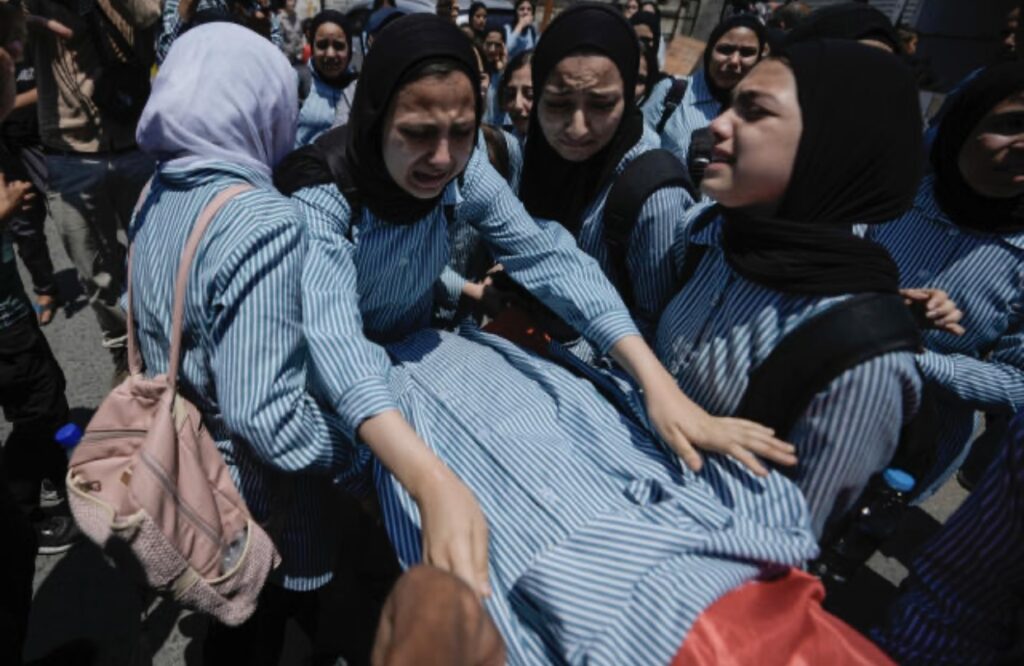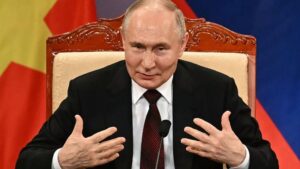At the funeral for Sadeel Naghniyeh, 15, her closest friends carried her lifeless body on their shoulders. Wearing their school uniforms — fitted black hijabs and oversized striped shirts — they walked through the Palestinian refugee camp, sobbing and struggling to utter the Islamic funeral prayers.
Sadeel was fatally shot in a suspected incident involving Israeli fire during a raid on the northern Jenin refugee camp last week, which sparked intense Israeli-Palestinian clashes in the occupied West Bank.
Traditionally, older men — relatives and friends — lead the procession with the flag-draped body in Palestinian funerals. However, at Sadeel’s funeral, her eighth-grade classmates wrapped her in the uniform she would never wear again.
“She was just a child. She had dreams of becoming a nurse and saving lives,” said her father, Ghassan Naghniyeh, 46, from his vine-covered driveway where Sadeel was shot. “They took my daughter’s life and shattered her dreams.”
Witness testimonies and surveillance videos suggest that there were no confrontations on her street at the time, and the clashes between Palestinian militants and Israeli forces were unfolding about 650 meters (700 yards) away from her home.
The killing of Sadeel — one of the 12 Palestinians under 16 years old killed by Israeli gunfire in the West Bank this year, according to The Associated Press — has drawn renewed attention to the military’s record of causing civilian casualties amid escalating violence in the region. Last year, the army launched a broad campaign in Palestinian towns and cities in response to a wave of Palestinian attacks within Israel.
According to the AP’s tally, nearly 140 Palestinians have been killed by Israeli gunfire in the West Bank this year, with almost half of them having ties to militant groups. The army claims that the actual number is much higher. However, civilians have also been among the casualties, including a 2-year-old boy earlier this month and a 15-year-old boy in the same raid on the Jenin camp last week. The death of the 15-year-old is also under military review.
“We are not just talking about Sadeel’s death; we are talking about daily killings without any accountability. This lack of accountability only paves the way for Israel to continue killing more civilians in the future,” said Shawan Jabarin, director of Al Haq, a Palestinian human rights group.
The Israeli army often accuses Palestinian militants of using residential areas as cover, thereby endangering civilians. Regarding Sadeel’s death, the army provided no explanation two days after the incident, stating that the circumstances are “under examination.”
Sadeel’s family believes that the bullet that killed her likely came from an Israeli army jeep passing through their quiet street that morning, according to surveillance footage. Neighbors said that the same jeep fired at and injured a woman in her 30s and a young man.
The last video recorded on Sadeel’s phone shows a similar military jeep traveling along a dusty road approximately 200 meters (yards) away from where she stood. It remains uncertain whether it was the same jeep. Shortly after posting the clip on Telegram, she lay brain-dead in her driveway.
The Israeli military declined to answer multiple inquiries about the military vehicles involved. While not directly addressing Sadeel’s case, the army stated that their arrest operation had triggered a “massive exchange of fire with terrorists,” and Israeli forces had opened fire on armed individuals and those throwing explosive devices.
Israeli military incursions often elicit Palestinian gunfire, leading to violent clashes. Israel argues that these intensified military activities are part of counterterrorism efforts and has concentrated its operations in the hometowns of assailants, particularly the city of Jenin and its adjacent refugee camp.
The camp has once
again become a stronghold of Palestinian militancy, two decades after it was invaded by Israel with tanks and helicopters, resulting in the destruction of homes. The scars of that major battle in 2002, one of the largest during the second Palestinian uprising, still linger.
“The martyrs from that battle are still dead. The prisoners are still in prison,” said Mohammed Shehata, the general manager of the Freedom Theater, which was co-founded by a prominent militant and provides drama classes and performance facilities for young Palestinians in the camp. “And now, the young people fighting today’s battles will pass their pain onto the next generation.”
Sadeel, who lived just behind the theater, could often be found there, observing auditions, joking with international volunteers, and participating in improv games during the summer camp, according to Shehata. He shared a video of a younger Sadeel dancing and singing with other children.
However, the conflict was always present. Residents claim that the rooftops in Sadeel’s neighborhood, on the outskirts of the camp, provided Israeli snipers with a clear view. Bullet holes from previous raids riddle her father’s parked white Kia.
Two of her uncles were Palestinian militants who were killed as teenagers during the second uprising, and two others remain imprisoned by Israel.
Sadeel’s Facebook profile picture features an unidentified girl wearing an abaya and holding a rifle in black and white. Several months ago, she wrote, “Oh God, I end my life according to your will.” Consumed by the daily news of Israeli and Palestinian attacks, killings, and clashes, Sadeel found it difficult to concentrate on school, according to her father.
Israeli officials often attribute the radicalization of Palestinian youth to incitement on social media. However, Sadeel’s uncle, Nidal Naghniyeh, described her admiration for militants as an inevitable result of growing up in the Jenin refugee camp.
“It’s the same in every household,” he said. “Sadeel had nothing around her except death and destruction. So, what else could she think about? What else could she dream of? Death.”
During last week’s Israeli military incursion into the camp, which involved military vehicles, bulldozers, and drones, Palestinian militants ambushed the forces with gunfire and powerful explosives. In response, the Israeli military dispatched helicopter gunships to assist in evacuating their stranded soldiers. Seven Palestinians were killed in the operation.
The incursion began with a familiar scene. Sirens blared throughout the camp, and militants fired into the air to warn residents of the intrusion. Naghniyeh and his wife led Sadeel and their four sons to the back of the house, closing all the windows.
Around 8 a.m., Sadeel became restless and asked her father if she could spend the day with her twin cousins, Sara and Yara, next door.
Considering it a safe and much-needed distraction, Naghniyeh agreed. Minutes after Sadeel descended the stairs, he heard the piercing screams of his 9-year-old son, Hamoudi.
In the driveway, Naghniyeh cradled Sadeel’s lifeless body and felt blood at the back of her head. He knew his only daughter was gone.
“Whoever shot her must have seen her,” he said. “Couldn’t they see that she was just a child?”
Read also
Blinken affirms no ongoing nuclear deal negotiations with Iran
Iran files lawsuit against Canada over state immunity dispute at United Nations top court



